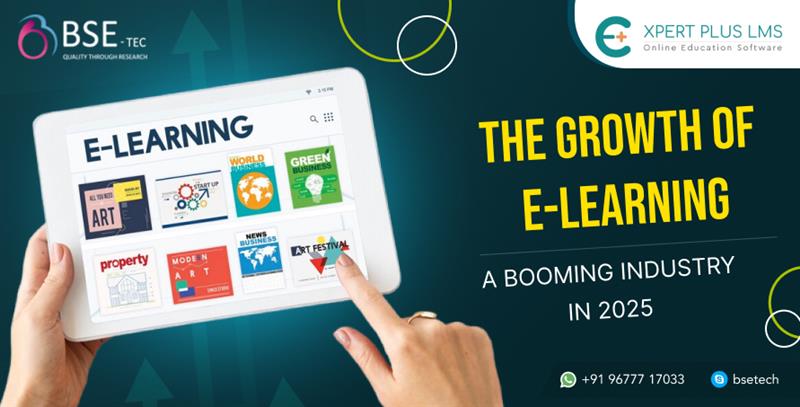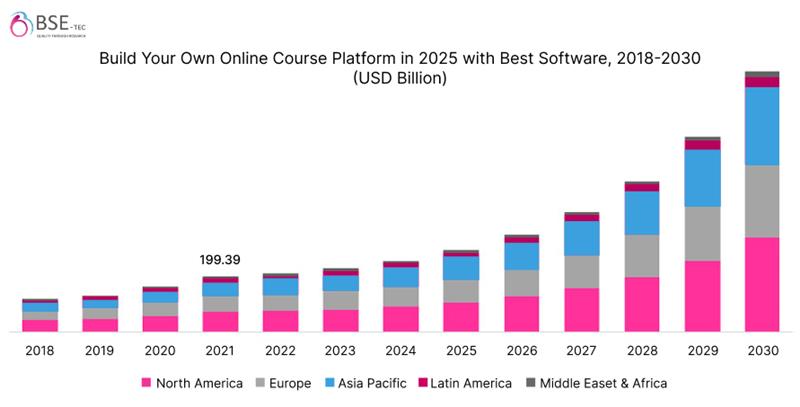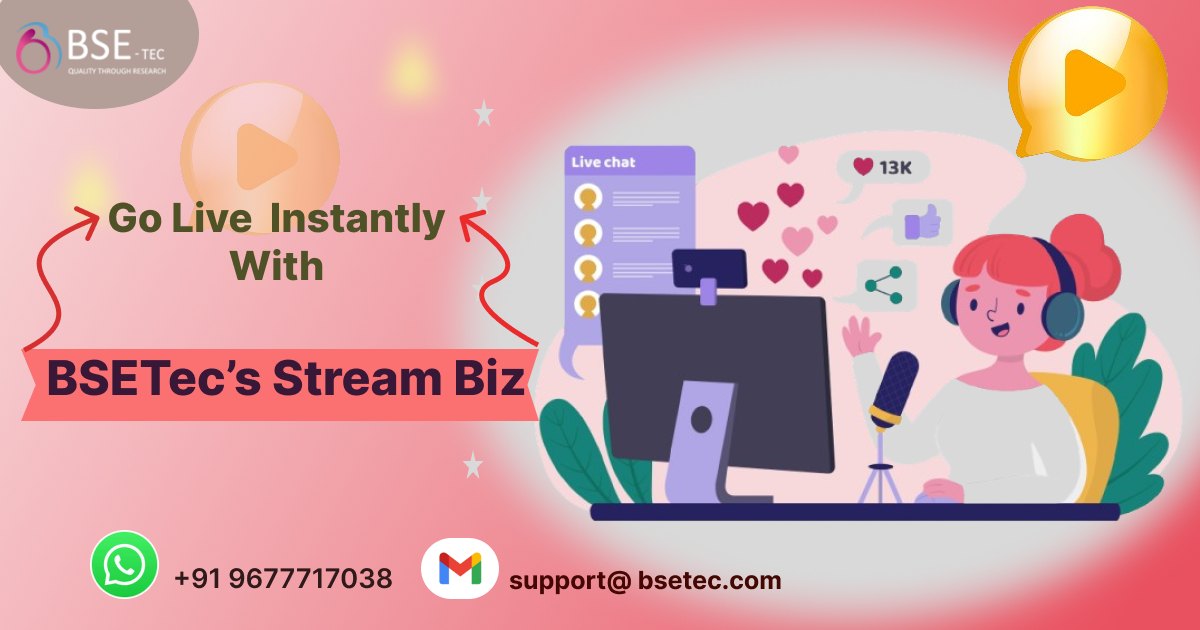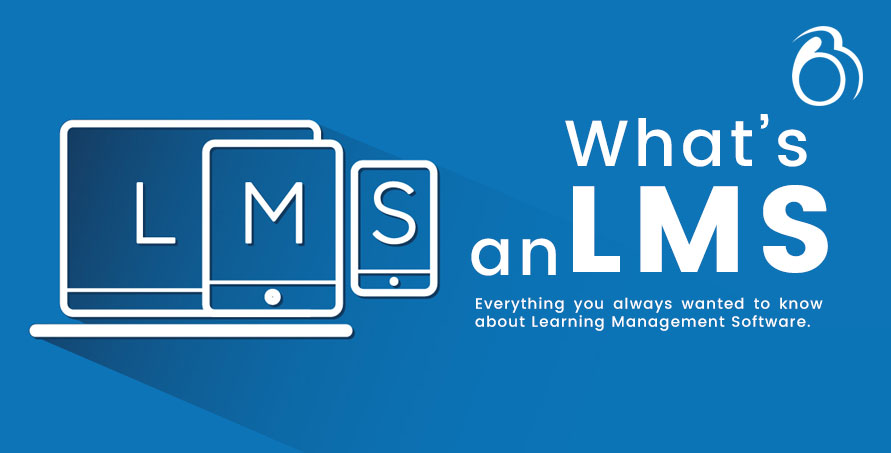
Create your own online course platform in 2025 with the best e-learning software. Easily build, manage, and monetize courses with powerful tools for success.
BSE Tec provides a powerful solution to build your own online course platform.In today’s digital age, online education has transformed the way we learn, teach, and share knowledge. Whether you’re an entrepreneur, educator, or business looking to launch your own e-learning marketplace, having a powerful and feature-rich platform is essential. That’s where BSEtec’s Udemy Clone script comes in — a ready-made solution designed to replicate the success of popular online course marketplaces like Udemy.
With comprehensive features covering course creation, payment integration, mobile compatibility, and more, BSEtec’s platform offers everything you need to build a scalable and engaging online learning environment. In this blog, we’ll explore the key features, mobile development capabilities, software modules, and support options that make this Udemy Clone a top choice for launching your own education platform in 2025.
Table Of Content
- Why Build Your Own Online Course Platform?
- The Growth of E-Learning: A Booming Industry in 2025
- What Does It Take to Build an Online Course Platform?
- How to Choose the Right Online Course Software?
- Step-by-Step Guide to Building Your Own Online Course Platform
- Cost to Build Your Own Online Course Platform in 2025
- How We Can Help You : Ready to use, Support, Service
- Conclusion: Get Started with Your Online Course Platform Today
Why Build Your Own Online Course Platform?
The e-learning industry is booming, and 2025 is the perfect time to get in. Building your own online course platform gives you full control,
allowing you to:
- Own your brand and content.
- Customize features like live video lessons, quizzes, and certification.
- Monetize freely—no commissions to third-party platforms.
- Engage students with interactive features and a community-driven learning experience.
- Scale easily and add more courses as your platform grows.
With BSE Tec’s Udemy Clone and Coursera Clone, you get a fully customizable, user-friendly platform that’s ready to grow with you.
The Growth of E-Learning: A Booming Industry in 2025

The e-learning industry is on track to reach $400 billion by 2026, and 2025 is shaping up to be a transformative year for online education.
Here’s why e-learning is booming:
- Increased Demand: With more people turning to online learning for personal development, professional skills, and even formal education, the demand for online courses is at an all-time high.
- Flexible Learning: The rise of remote work and busy lifestyles makes online learning the preferred option for students of all ages. People want to learn at their own pace, from anywhere, and on any device.
- Global Reach: E-learning platforms allow you to reach a global audience. From a local business to a worldwide community of learners, the potential for growth is limitless.
- Technological Advancements: Emerging technologies like AI, virtual reality (VR), and blockchain are shaping the future of e-learning. These innovations are making learning more engaging and personalized than ever.
- Lower Costs: Online courses cut down on overhead costs, making education more affordable for both instructors and students. The scalability of e-learning allows for more courses to be created with fewer resources.
What Does It Take to Build an Online Course Platform?
Building an online course platform involves these key steps:
- Planning
- Pick Your Niche: Choose the subjects or skills your platform will cover.
- Understand Your Audience: Know who you’re creating the platform for (e.g., professionals, students).
- Pick Your Niche: Choose the subjects or skills your platform will cover.
- Platform Selection
- Use a customizable solution like BSE Tec’s Udemy Clone to get started quickly.
- Set up a reliable hosting and domain.
- Use a customizable solution like BSE Tec’s Udemy Clone to get started quickly.
- Design & User Experience
- Make sure your platform is easy to navigate and mobile-friendly for users everywhere.
- Make sure your platform is easy to navigate and mobile-friendly for users everywhere.
- Course Management
- Include tools for instructors to upload content, track student progress, and offer quizzes and certificates.
- Include tools for instructors to upload content, track student progress, and offer quizzes and certificates.
- Payment Systems
- Integrate payment options (PayPal, credit card) and choose a pricing model (subscription, one-time fee).
- Integrate payment options (PayPal, credit card) and choose a pricing model (subscription, one-time fee).
- Marketing
- Optimize for SEO to get traffic and build a community through engagement.
- Optimize for SEO to get traffic and build a community through engagement.
- Maintenance
- Regularly update your platform and provide strong customer support to keep users happy.
How to Choose the Right Online Course Software?
Choosing the right online course software is crucial for building a successful e-learning platform.
Here’s what you should consider:
- Ease of Use
- User-Friendly Interface: Ensure both students and instructors can easily navigate the platform.
- Customization Options: Look for software that allows you to personalize your platform’s design and features.
- User-Friendly Interface: Ensure both students and instructors can easily navigate the platform.
- Scalability
- Choose a platform that can grow with your business. It should handle more courses, users, and traffic as your platform expands.
- Choose a platform that can grow with your business. It should handle more courses, users, and traffic as your platform expands.
- Course Management Features
- Look for features like course creation tools, student progress tracking, quizzes, and certificates.
- Ensure instructors can easily upload and organize content.
- Look for features like course creation tools, student progress tracking, quizzes, and certificates.
- Payment Integration
- The software should support multiple payment options (e.g., credit cards, PayPal) and pricing models like subscriptions or one-time payments.
- The software should support multiple payment options (e.g., credit cards, PayPal) and pricing models like subscriptions or one-time payments.
- Mobile Compatibility
- Make sure your platform works smoothly on mobile devices so students can learn on the go.
- Make sure your platform works smoothly on mobile devices so students can learn on the go.
- Support & Updates
- Look for a platform that offers customer support and regular software updates to stay current with new features and security patches.
- Look for a platform that offers customer support and regular software updates to stay current with new features and security patches.
- SEO & Marketing Tools
- Your platform should help you optimize for SEO, offer email marketing integrations, and support social sharing to help attract students.
- Your platform should help you optimize for SEO, offer email marketing integrations, and support social sharing to help attract students.
- Security
- Ensure the software is secure with features like SSL encryption, data protection, and secure payment processing.
Step-by-Step Guide to Building Your Own Online Course Platform
1. Define Your Vision and Niche
Before diving into the technical side, spend time determining:
- Target Audience: Who are you creating the platform for? (e.g., teachers, entrepreneurs, hobbyists, etc.)
- Course Topics: What kinds of courses will be offered? (e.g., business, tech, art, fitness)
- Business Model: Will it be a subscription-based service, pay-per-course, or freemium model?
- Unique Value Proposition: What will set your platform apart from existing ones like Udemy or Teachable?
2. Research and Analyze Competitors
Study existing online course platforms to understand:
- Features They Offer: Course creation tools, quizzes, certifications, user forums, etc.
- User Experience (UX): How easy is it to navigate the platform?
- Pricing and Monetization: How do they structure their pricing? Do they have affiliate programs or partnerships?
3. Plan Core Features
What are the must-have features for your platform? Common ones include:
- Course Creation Tools: Simple interfaces for uploading videos, quizzes, assignments, and documents.
- User Management: Features for enrolling users, tracking progress, and providing certificates.
- Payment Gateway: Integration for course sales, recurring subscriptions, etc.
- Community Engagement: Forums, discussion boards, or live Q&A.
- Analytics and Reporting: Insights on student progress, course performance, and sales.
- Mobile Accessibility: Ensure the platform works seamlessly on mobile devices.
4. Choose the Technology Stack
Decide whether to build the platform from scratch or use existing tools. Options include:
- Custom Development: Hiring a team to build your platform using web technologies like React, Node.js, Python, etc.
- Open-Source Platforms: Use existing open-source course platforms like Moodle or Open edX.
- SaaS Builders: Platforms like Teachable, Thinkific, or Podia that let you create a course site without deep technical expertise.
- No-Code Tools: Platforms like Bubble or Glide that let you create apps or websites with little to no coding.
5. Design the User Interface (UI) and User Experience (UX)
Good design is critical for retaining users. Focus on:
- Ease of Navigation: Clear menus, search functionality, and an intuitive layout.
- Course Page Design: A clean, professional look with videos, descriptions, and course details.
- Responsive Design: Ensure your platform is optimized for both desktop and mobile devices.
- Branding: Create a visually appealing and cohesive brand experience.
6. Develop Core Functionalities
If you’re developing from scratch or customizing an open-source platform, you’ll need to implement:
- User Registration/Login: Allow users to sign up and sign in securely (email, social logins, etc.).
- Payment Integration: Use Stripe, PayPal, or other gateways to accept payments.
- Course Management: A system for instructors to upload and organize content (videos, PDFs, quizzes).
- Progress Tracking: Students should be able to see their learning progress and scores.
- Certificates: Automate the generation of certificates upon course completion.
7. Build a Content Delivery System
You’ll need a system to host and deliver your course content. Options include:
- Cloud Storage Services: Like AWS S3, Google Cloud, or Vimeo for video hosting.
- Content Protection: Implement security measures like video encryption, watermarks, or download restrictions.
- Content Delivery Network (CDN): To improve speed and ensure smooth streaming worldwide.
8. Test and Debug
Testing is essential to ensure the platform works correctly. Areas to focus on include:
- Functionality Testing: Test all features (payment processing, course enrollment, content access).
- User Experience Testing: Make sure the platform is easy to navigate.
- Load Testing: Ensure the platform can handle multiple users at once without crashing.
- Mobile Testing: Ensure the platform is fully responsive on different devices.
9. Launch the Platform
After thorough testing, it’s time to launch. You can:
- Beta Launch: Release the platform to a small group of users for feedback before the official launch.
- Official Launch: Promote the platform through email lists, social media, and paid ads.
10. Marketing Your Platform
Attract users and course creators by:
- Content Marketing: Blog posts, tutorials, or free resources related to your niche.
- Social Media Campaigns: Use platforms like Instagram, LinkedIn, and Facebook to engage potential customers.
- Affiliate Marketing: Set up an affiliate program to allow others to promote your courses in exchange for commissions.
- SEO Optimization: Optimize your site for search engines to drive organic traffic.
11. Scale and Improve
After the initial launch, focus on:
- User Feedback: Continually improve the platform based on user feedback.
- New Features: Add advanced features like live sessions, advanced analytics, or AI-driven course recommendations.
- Expand Your Course Library: Offer more courses in diverse categories to attract a broader audience.
- Optimize Performance: Regularly update the platform to handle increased traffic and ensure fast loading times.
12. Monetize Your Platform
Once you’ve gained traction, you can further monetize your platform by:
- Subscription Plans: Offer monthly or yearly subscription options for users to access all content.
- Premium Courses: Offer high-quality, premium courses at higher prices.
- Instructor Partnerships: Allow instructors to create and sell their courses for a commission or flat fee.
- Sponsorships and Ads: Collaborate with brands for ads or sponsored content.
Recommended Tools for Building Your Platform
- Website Builders
- Wix, WordPress (with LearnDash), or Squarespace for easy-to-use course platforms.
- Wix, WordPress (with LearnDash), or Squarespace for easy-to-use course platforms.
- Payment Gateways
- Stripe, PayPal, or Square for processing payments.
- Stripe, PayPal, or Square for processing payments.
- Video Hosting
- Vimeo Pro, Wistia, or AWS for secure video streaming.
- Vimeo Pro, Wistia, or AWS for secure video streaming.
- Learning Management System (LMS)
- Teachable, Thinkific, or LearnDash for quick course creation and management.
- Teachable, Thinkific, or LearnDash for quick course creation and management.
- Community Features
- Discourse or BuddyPress for forums and community interaction.
- Discourse or BuddyPress for forums and community interaction.
Cost to Build Your Own Online Course Platform in 2025

The cost of building an online course platform in 2025 can vary depending on your approach and goals.
How We Can Help You : Ready to use, Support, Service
Our Udemy Clone platform helps you launch a professional online course website quickly and easily. It includes essential software modules like user management, course creation, payment processing, content protection, and analytics. The platform is mobile-friendly, customizable, and backed by strong support. Plus, built-in marketing tools and secure payment options help you attract students and grow your business.Our Clients Reviews & Portfolio
Our Bse Tec Platform Affordable & Best Plans
| Plan | Cost | Support | Key Features |
| Basic | Free | 7 days | Core LMS, PayPal, SEO, quizzes, certs |
| Enterprise | $299 | 1 month | Social login, Stripe/CCAvenue, blog, forum, apps |
| Ultimate | Custom | 3 months | Full source code, premium support & flexibility |
Small projects or trials: Basic plan is ideal.
Fully functional standalone platform: Enterprise plan is highly affordable and feature-rich at $299.
Agencies or multi-site use cases: Ultimate offers full source-code control, extended support, and multi-site licensing—great for heavy customization.
Conclusion: “Get Started with Your Online Course Platform Today”
The e-learning market is exploding, and 2025 presents massive opportunities for entrepreneurs, educators, and businesses to enter this space. With platforms like BSE Tec’s Udemy Clone and Coursera Clone, you can tap into this booming industry and build your own e-learning empire.
Did you find this article useful? Let us know by leaving a comment below, or join us on Twitter and Facebook.


